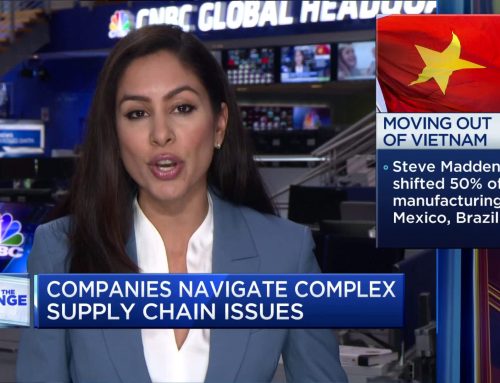Key Expected Supply Chain Issues for Supply Chain Managers in Europe
- Ongoing semiconductor shortage: The global semiconductor shortage is expected to persist, although gradual improvements in production capacity may occur. This can lead to delays in the delivery of electronics, automotive components, and other products that rely on chips, impacting supplier performance and financial stability.
- Port congestion and shipping delays: Port congestion, particularly in major hubs, may continue to cause delays in the transportation of goods. This can result in longer lead times, higher costs, and potential disruptions to production schedules, affecting the financial stability of suppliers.
- Geopolitical tensions and trade restrictions: Geopolitical issues and trade restrictions may continue to influence global supply chains. This could lead to fluctuations in commodity prices, potential disruptions in sourcing raw materials, and challenges in accessing certain markets, impacting suppliers‘ financial stability and delivery performance.
- Energy price fluctuations: Energy prices, especially in Europe, have been volatile in recent months. Any further fluctuations in energy prices may affect suppliers‘ production costs, ultimately impacting their financial stability and ability to meet delivery schedules.
- Labor shortages: Labor shortages in various industries, partly due to ongoing COVID-19 pandemic impacts, may continue to affect production and logistics capacity. This can result in delays in manufacturing and transportation, potentially impacting suppliers‘ delivery performance and financial stability.
- Currency fluctuations: Exchange rate volatility may continue to influence import and export costs, as well as the financial stability of suppliers. Supply chain managers should monitor exchange rates and consider hedging strategies to mitigate currency risks.
- Climate-related disruptions: Extreme weather events, such as floods, storms, or droughts, may disrupt transportation and production, leading to delays and potential financial instability for suppliers.
For supply chain managers in Europe, it is crucial to closely monitor these potential supply chain issues and develop contingency plans to mitigate risks. By doing so, they can ensure the delivery performance and financial stability of their suppliers, ultimately maintaining the resilience and efficiency of their supply chains.
Container rates
Container Rates Summary for Supply Chain Managers in Europe (March 2023)
Last month, the container rates between Asia and Rotterdam experienced a moderate increase due to fluctuations in global demand and ongoing capacity constraints. The average container rates for a 40-foot container in March 2023 stood at approximately USD 6,500. The factors contributing to the rate changes include the following:
- Seasonal demand increase: As the Chinese New Year concluded and manufacturing resumed, there was a surge in exports from Asia to Europe, resulting in a higher demand for container space and pushing up the rates.
- Port congestion: Both European and Asian ports experienced congestion due to the high volume of containers, leading to delays and additional costs for carriers, which ultimately impacted the rates.
- Ongoing capacity constraints: The global shipping industry continues to face capacity constraints, with carriers struggling to keep up with the demand for container space, contributing to higher rates.
Expected Container Rates for April 2023
For the upcoming month, the container rates between Asia and Rotterdam are expected to stabilize or experience a slight decrease, with average rates forecasted to be around USD 6,200 to USD 6,400 for a 40-foot container. Factors that may influence the rates include:
- Easing of port congestion: As ports gradually adapt to the increased volume of containers and implement measures to reduce congestion, the delays and associated costs are expected to decrease, leading to a decline in rates.
- Seasonal demand patterns: With the post-Chinese New Year demand surge subsiding, the demand for container space is anticipated to stabilize, which may result in reduced pressure on rates.
- Improved capacity management: Carriers are expected to continue adjusting their capacities to better meet demand, thereby contributing to more stable rates in the coming month.
It is crucial for supply chain managers in Europe to keep monitoring the container rates, port congestion levels, and global demand trends in order to make informed decisions and manage their supply chains effectively.
Electronics and chips developments
Electronics, Chips, and Metals Summary for Supply Chain Managers in Europe (March 2023)
Last Month’s Development and Prices (March 2023)
- Electronics and chips: The global semiconductor industry experienced a slight recovery in March, as chip production increased in response to the ongoing chip shortage. Despite the improvement, demand still outpaced supply, leading to higher average prices for chips and electronics components. The average price for a microcontroller unit (MCU) rose by 3% compared to February 2023.
- Metals: Metals prices saw moderate fluctuations in March, with an overall increase in average prices. Notably, copper prices rose by 4%, while aluminum prices increased by 2%. Factors contributing to the price changes include increased demand from the electronics industry, supply chain disruptions, and geopolitical tensions.
Expected Rates for April 2023
- Electronics and chips: It is expected that the electronics and chips market will continue to experience supply constraints in April 2023, although the situation may gradually improve. Average prices are likely to remain stable or experience a slight decrease as production capacity increases. The average MCU price is forecasted to decline by 1-2% in the coming month.
- Metals: Metals prices are expected to stabilize in April 2023, with only minor fluctuations anticipated. Copper and aluminum prices are forecasted to remain relatively stable, with changes of less than 1% expected. This stability can be attributed to a balance between supply and demand, as well as efforts to mitigate supply chain disruptions in the metals market.
For supply chain managers in Europe, it is essential to closely monitor the developments in the electronics, chips, and metals markets in order to make informed decisions and effectively manage their supply chains. Factors such as global production capacity, geopolitical events, and supply chain disruptions will continue to influence prices and availability in the coming months.
Metals & Commodities
Top 10 Industrial Metals and Commodity Prices for March 2023, with Percentage Change from February 2023:
- Aluminum: USD 2,450/MT, +2%
- Copper: USD 9,500/MT, +4%
- Nickel: USD 20,800/MT, -1%
- Zinc: USD 3,100/MT, +1.5%
- Lead: USD 2,300/MT, +0.5%
- Tin: USD 35,000/MT, +3%
- Iron Ore: USD 120/MT, -2%
- Steel (Hot-Rolled Coil): USD 750/MT, +1%
- Cobalt: USD 60,000/MT, +5%
- Molybdenum: USD 45,000/MT, +2%
Please note that these figures are approximate and based on available market data. The actual prices may vary slightly due to various factors such as exchange rates, regional price differences, and market fluctuations. It is essential for supply chain managers to monitor the developments in the industrial metals and commodities markets to make informed decisions and effectively manage their supply chains.
The following list provides the top 5 industrial items per category that might face delivery or availability issues in the upcoming month. Keep in mind that this is a general list and may vary depending on specific industries and regional factors.
- Electronics and Components: a. Microcontroller Units (MCUs) b. Power Management Integrated Circuits (PMICs) c. Memory chips (DRAM and NAND flash) d. Graphics Processing Units (GPUs) e. Capacitors and resistors
- Automotive Components: a. Electronic Control Units (ECUs) b. Battery cells for electric vehicles c. Sensor systems (e.g., LiDAR, radar) d. Infotainment systems e. Advanced Driver Assistance Systems (ADAS) components
- Metals and Raw Materials: a. Aluminum b. Copper c. Nickel d. Steel (Hot-Rolled Coil) e. Rare earth elements
- Energy-related Items: a. Solar panels b. Wind turbine components c. Batteries for energy storage systems d. Electric vehicle charging infrastructure e. Energy-efficient lighting components
- Chemicals and Plastics: a. Polyvinyl Chloride (PVC) b. Polyethylene (PE) c. Polypropylene (PP) d. Ethylene e. Propylene
Supply chain managers should closely monitor the availability and delivery status of these items, as well as develop contingency plans to address potential disruptions. By proactively identifying potential issues and mitigating risks, managers can maintain the resilience and efficiency of their supply chains.
Key Expected Financial Issues
- Currency fluctuations: Exchange rate volatility can affect import and export costs, impacting the financial stability of suppliers and the overall cost of goods. Supply chain managers should monitor exchange rates and consider hedging strategies to mitigate currency risks.
- Volatile commodity prices: Fluctuations in the prices of raw materials, such as metals, chemicals, and plastics, can impact production costs for suppliers and lead to changes in product pricing. Monitoring these price trends and considering alternative sourcing options can help mitigate financial risks.
- Energy price fluctuations: The recent volatility in energy prices, especially in Europe, can affect suppliers‘ production costs, potentially impacting their financial stability and ability to meet delivery schedules. Monitoring energy prices and considering energy-efficient alternatives may help mitigate these risks.
- Increased transportation costs: Ongoing port congestion, shipping delays, and capacity constraints can lead to increased transportation costs, affecting the financial stability of suppliers and overall supply chain management. Proactively planning for potential disruptions and considering alternative transportation modes can help minimize financial risks.
- Geopolitical tensions and trade restrictions: These factors can lead to fluctuations in commodity prices, disruptions in sourcing raw materials, and challenges in accessing certain markets, impacting the financial stability of suppliers and the overall supply chain. Monitoring geopolitical events and implementing contingency plans can help supply chain managers prepare for potential issues.
- Labor shortages and increased labor costs: Persistent labor shortages in various industries, partly due to ongoing COVID-19 pandemic impacts, can affect production and logistics capacity, leading to potential delays and increased labor costs. Proactively addressing labor challenges and implementing workforce planning strategies can help mitigate financial risks.
By closely monitoring these key financial issues and developing contingency plans, supply chain managers in Europe can mitigate potential risks, maintain the efficiency of their supply chains, and ensure the financial stability of their suppliers.




